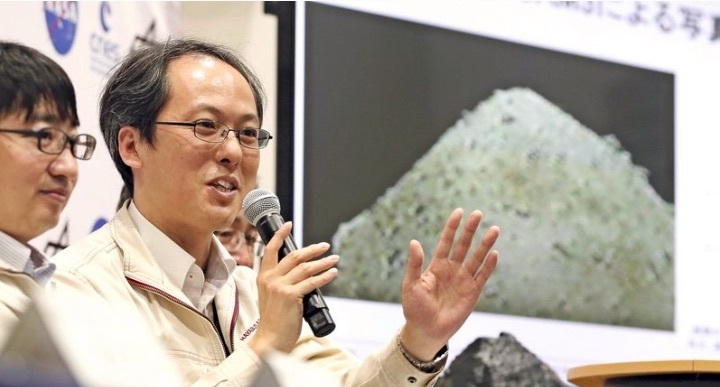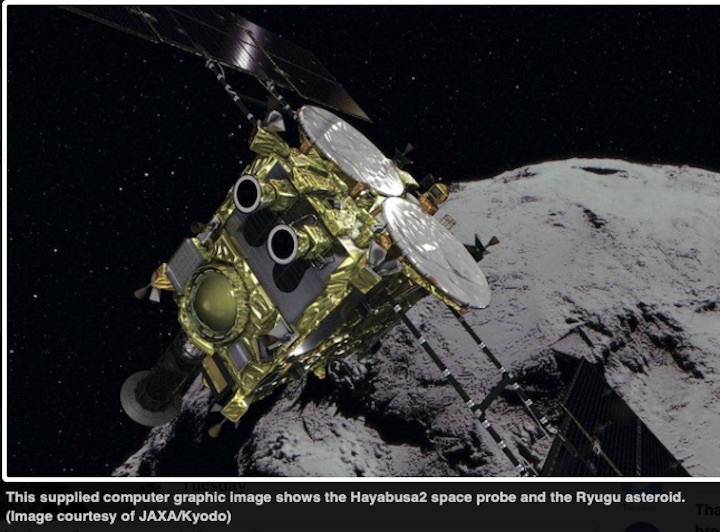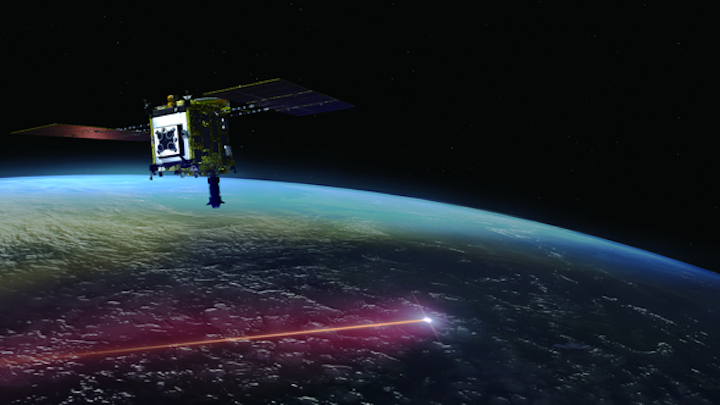Japan’s Hayabusa2 spacecraft is nearly home. Having collected samples from the asteroid Ryugu last year, the spacecraft is just months away from returning them to Earth. The samples contain material that likely dates back to the dawn of the solar system, 4.6 billion years ago. They could provide fresh insights into how celestial bodies came to be and even how life on Earth began. But before all that, there is the small matter of getting Hayabusa2’s precious cargo down from the harsh vacuum of space and safely into scientists’ hands.
On July 14 the Japanese Aerospace Exploration Agency (JAXA), in partnership with the Australian Space Agency, announced the landing date for the samples: December 6, 2020. JAXA’s landing site for the mission is a 122,000-square-kilometer region of South Australian outback known as the Woomera Range Complex. “Woomera is a very remote area,” says Karl Rodrigues, acting deputy director of the Australian Space Agency. “It makes it ideal for the safe management and landing of this particular craft and capsule.”
Hayabusa2’s predecessor, Hayabusa, also used the Woomera landing site when it returned a capsule containing about a millionth of a gram of dust from the asteroid Itokawa in 2010. That mission had been planned to retrieve far more, but it was hindered by multiple mishaps in deep space. Hayabusa2’s haul from Itokawa should be larger—up to a gram of material. JAXA is not alone in struggling with sample-return efforts: in 2004 NASA also experienced some issues with its Genesis solar-particle-retrieval capsule, which slammed into the Utah desert after a parachute failed to deploy. The U.S. space agency’s Stardust capsule—which carried samples of Comet Wild 2’s tail—fared better when it landed safely in 2006.
Hayabusa2, similar in design to its predecessor, launched in 2014 and arrived at Ryugu in June 2018. It descended to the asteroid’s surface in February 2019, firing a small projectile into the ground and hopefully scooping material up into a container (there is no way to know for sure that the maneuver was successful until the capsule returns to Earth). In April 2019 the spacecraft fired an impactor into Ryugu from a distance, forming a small crater. Then it swooped down again in July 2019 to grab material ejected by the impact. Last November Hayabusa2 finally left its orbit around the asteroid and began its one-year journey home.
When Hayabusa2 flies by Earth in December, it will drop off the sample capsule, which must endure a fiery reentry in our atmosphere before parachuting safely to the ground. The spacecraft will head back into space, on an extended mission to one of two possible additional asteroids. On the ground, a team of about 10 JAXA scientists—few enough that coronavirus restrictions should not hamper the recovery efforts—will await the capsule’s arrival. They will rely on its radio beacon, as well as drone-based reconnaissance, to locate its precise touchdown site. The scientists’ aim will be to find the capsule within 100 hours of landing. “Probably, we can find it more quickly,” says Satoru Nakazawa, the deputy manager on the Hayabusa2 team. Hayabusa’s capsule, for instance, was found within 24 hours. “But in the case of some trouble, it can take more time,” he says.
Once the capsule is found, it will be taken to a nearby building in Woomera called the Quick Look Facility. Most studies of the samples will take place in Japan, at the Extraterrestrial Sample Curation Center (ESCuC) in the city of Sagamihara, near Tokyo. But some preliminary analysis will be conducted in Australia. Gazing through a small hole into the capsule’s two sample containers—one from each landing site on the asteroid—team members will first confirm there are actually some samples to study. They will then siphon any volatile gases, such as water vapor, from the containers to ensure these more delicate components of the samples are not spoiled by exposure to Earth’s atmosphere. “Without opening the container, we can take out any volatiles released inside,” says Shogo Tachibana, who leads Hayabusa2’s sample analysis team. “We will put those volatiles into gas tanks and make a quick analysis.”
Following this early analysis, roughly a day after the capsule’s return to Earth, JAXA will fly the samples to ESCuC. There, in a clean room, the capsule containers will be opened for the first time. A portion of the samples will immediately be set aside and stored for future generations to study, ideally with more advanced equipment than is available today. (Something similar was done with moon samples from the Apollo program, which are still only gradually being opened.) The remainder will be transferred to a chamber filled with pure, inert nitrogen gas. “All the samples will be handled, photographed, weighed, and [we’ll make] nondestructive spectroscopic observations, ready for further analysis,” Tachibana says.
JAXA scientists will have about a year to perform initial studies of the samples (early results from the mission suggest Ryugu, despite being composed of ancient material, may have only formed into its current shape 10 million years ago). After this work, some of the retrieved samples may be sent out to international partners for further examination, depending on how much material is available to distribute. That process will likely entail a deal for a swap with NASA’s own asteroid-sample-retrieval mission, called OSIRIS-REx, which is scheduled to return to Earth from the asteroid Bennu in 2023. “Half a percent of [our] sample will be sent to Japan in exchange for Hayabusa2 samples,” says Jason Dworkin of NASA’s Goddard Space Flight Center, who is project scientist for OSIRIS-REx.
Hayabusa2 will have the first turn in the limelight, however. And if all goes to plan, it could provide a fascinating glimpse into the early solar system—and possibly even our own beginnings here on Earth. Scientists will search its samples for signs of hydrated minerals, organic material and other building blocks of biology. “We’re very interested, fundamentally, in the origin of life,” says planetary scientist Rhian Jones of the University of Manchester in England, who is hoping to study some of Hayabusa2’s primordial souvenirs herself. “Getting samples back from an asteroid like this is a really important part of that.”
Quelle: SCIENTIFIC AMERICAN
----
Update: 21.08.2020
.
The Hayabusa2 Re-entry Capsule Approved to Land in Australia
National Research & Development Agency
Japan Aerospace Exploration Agency (JAXA)
On August 10, 2020, JAXA was informed that the Authorisation of Return of Overseas-Launched Space Object (AROLSO) for the re-entry capsule from Hayabusa2 was issued by the Australian Government. The date of the issuance is August 6, 2020.
The Hayabusa2 re-entry capsule will return to Earth in South Australia on December 6, 2020 (Japan Time and Australian Time). The landing site will be the Woomera Prohibited Area. The issuance of the AROLSO gave a major step forward for the capsule recovery.
We will continue careful operation for return of Hayabusa2 and recovery of the capsule, and the operation status will be announced in a timely manner.
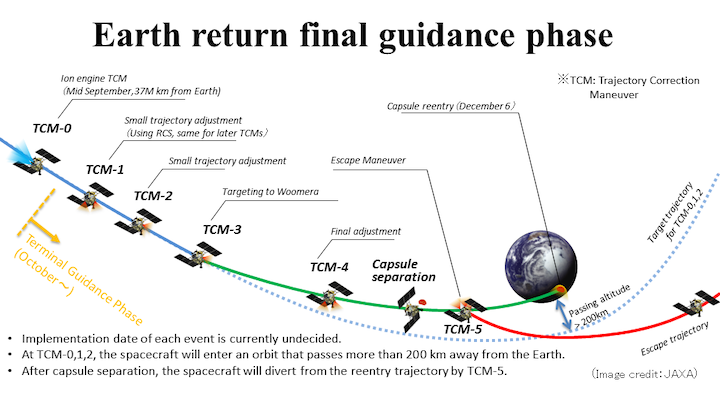
Comment from JAXA President, Hiroshi Yamakawa
The approval to carry out the re-entry and recovery operations of the Hayabusa2 return sample capsule is a significant milestone. We would like to express our sincere gratitude for the support of the Australian Government as well as multiple organizations in Australia for their cooperation.
We will continue to prepare for the successful mission in December 2020 in close cooperation with the Australian Government.
Quelle: JAXA
----
Update: 30.10.2020
.
Asteroid Ryugu shaken by Hayabusa2’s impactor
The artificial impactor disturbed boulders within a 30m radius from the center of the impact crater- providing important insight into asteroids’ resurfacing processes.
Professor ARAKAWA Masahiko (Graduate School of Science, Kobe University, Japan) and members of the Hayabusa2 mission discovered more than 200 boulders ranging from 30cm to 6m in size, which either newly appeared or moved as a result of the artificial impact crater created by Japanese spacecraft Hayabusa2’s Small Carry-on Impactor (SCI) on April 5th, 2019. Some boulders were disturbed even in areas as far as 40m from the crater center. The researchers also discovered that the seismic shaking area, in which the surface boulders were shaken and moved an order of cm by the impact, extended about 30m from the crater center. Hayabusa2 recovered a surface sample at the north point of the SCI crater (TD2), and the thickness of ejecta deposits at this site were estimated to be between 1.0mm to 1.8cm using a Digital Elevation Map (DEM). These findings on a real asteroid’s resurfacing processes can be used as a benchmark for numerical simulations of small body impacts, in addition to artificial impacts in future planetary missions such as NASA’s Double Asteroid Redirection Test (DART). The results will be presented at the 52nd meeting of the AAS Division of Planetary Science on October 29th in the session entitled Asteroids: Bennu and Ryugu 2.
The aim of impacting Ryugu with a ~13cm SCI projectile was to recover a sample of the subsurface material. In addition, this provided a good opportunity to study the surface renewal processes (resurfacing) that result from an impact occurring on an asteroid with a surface gravity of 10-5 of the Earth’s gravity. The SCI succeeded in forming an impact crater, which was defined as a SCI crater with a diameter of 14.5 m (Arakawa et al., 2020), and the surface sample was recovered at TD2 (10.04°N, 300.60°E) (Fig. 1). It was discovered that the crater center’s concentric area, which has a radius four times larger than the crater radius, was also disturbed by the SCI impact, causing boulder movement.
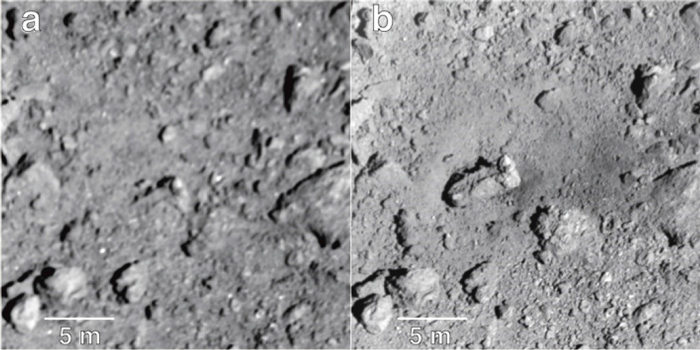
Figure 1. High-resolution ONC images before and after the SCI impact. Both images are registered in an ONC latitude-longitude mosaic map.
Image credit: JAXA, The University of Tokyo, Kochi University, Rikkyo University, Chiba Institute of Technology, Meiji University, The University of Aizu, AIST.The researchers subsequently compared surface images before and after the artificial impact in order to study the resurfacing processes associated with cratering, such as seismic shaking and ejecta deposition. To do this, they constructed SCI crater rim profiles using a Digital Elevation Map (DEM) consisting of the pre-impact DEM subtracted from the post-impact DEM (Fig. 2). The average rim profile was approximated by the empirical equation of h=h rexp[-(r/R rim - 1)/λrim] and the fitted parameters of h r and λrim were 0.475m and 0.245m, respectively. Based on this profile, the SCI crater’s ejecta blanket thickness was calculated and found to be thinner than that of the conventional result for natural craters, as well as that calculated from the crater formation theory. However, this discrepancy was solved by accounting for the effect of the boulders that appeared on the post-impact images because the crater rim profiles derived from the DEMs might fail to detect these new boulders (Fig. 3). According to this crater rim profile, the thickness of the ejecta deposits at TD2 were estimated to be between 1.0mm to 1.8cm.
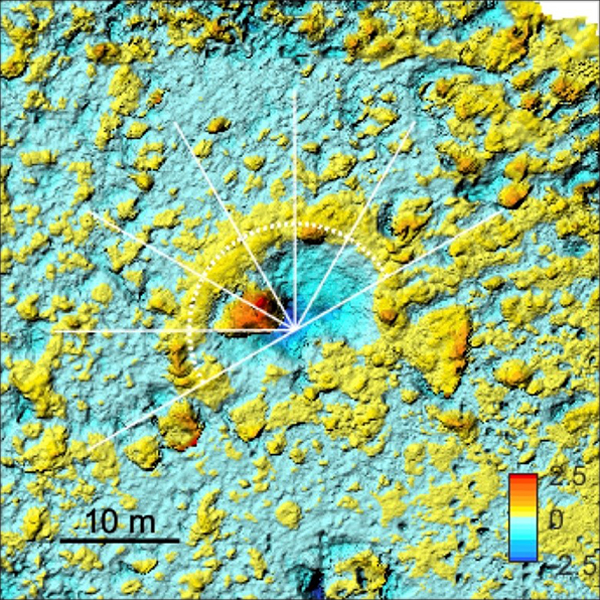
Figure 2. The difference between the pre-impact surface DEM and the post-impact surface DEM around the SCI impact point.
The color scale indicates the height of the surface morphology in meters, and the dotted semicircle shows the SCI crater rim. Image credit: Kobe University, JAXA, The University of Tokyo, Kochi University, Rikkyo University, Chiba Institute of Technology, Meiji University, The University of Aizu, AIST.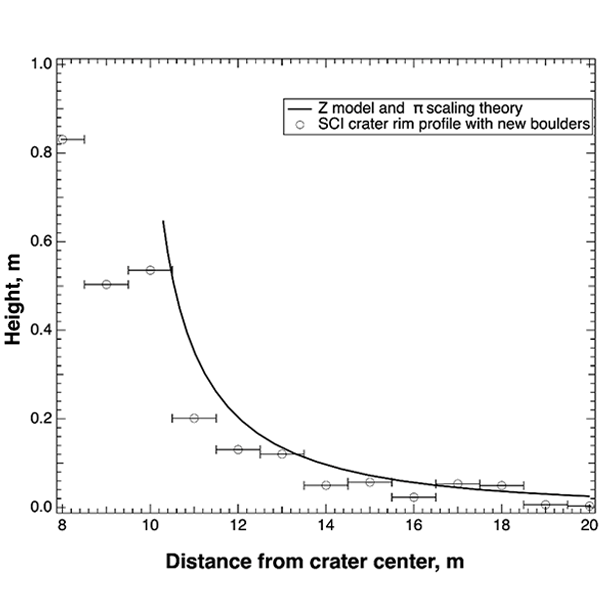
Figure 3. Comparison between the theoretical crater rim height and the SCI crater rim height (with the addition of new boulders).
Image credit: Kobe University.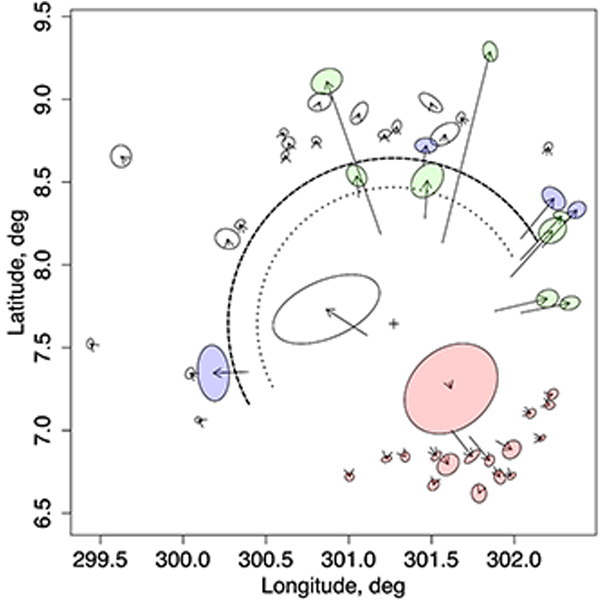
Figure 4. Distribution of traced boulders inside and outside the SCI crater. The inner and outer semicircles described by a thin dotted line and a thick dotted line, show the apparent crater diameter and the rim diameter of the SCI crater, respectively.
The initial positions of the boulders represented by red ellipses are located outside of the apparent crater to the south of the SCI crater, and that of the purple ellipses are located between the apparent crater radius and the crater rim radius. The shape and position of each ellipsis indicates the approximate shape and scale of the boulder and the post impact position, respectively. Two large boulders named Okamoto and Iijima, and a medium-sized boulder named mb19 are shown for reference. Image credit: Kobe University, JAXA.The 48 boulders in the post-impact image could be traced back to their initial positions in the pre-impact image, and it was found that the 1m-sized boulders were ejected several meters outside of the crater. They were classified into the following four groups according to their motion mechanisms: 1. excavation flow, 2. pushed by falling ejecta, 3. surface deformation dragged by the slight movement of the Okamoto boulder, and 4. seismic shaking caused by the SCI impact itself (Fig. 4). In all groups, the motion vectors of these boulders seemed to radiate from the crater center.
The 169 new boulders ranging from 30cm to 3m in size were found only in the post-impact images, and they were distributed up to ~40m from the crater center. The histogram of the number of new boulders was studied in each radial width of 1m at a distance of 9–45m from the crater center, with the maximum number of boulders being found at a distance of 17m. Beyond 17m, the number of boulders decreased in accordance with the increase in distance from the crater center.
To investigate this further, a correlation coefficient evaluation between the pre- and post-impact images was carried out. It was discovered that the low cross-correlation coefficient region outside the SCI crater has an asymmetric structure (Fig. 5), which is very similar to the area around the impact point where ejecta were deposited (Arakawa et al., 2020). Based on a template matching method using the correlation coefficient evaluation, the boulder displacements with cross-correlation coefficients above 0.8 were derived with a resolution of ~1cm. This indicated that these displacements could be caused by the seismic shaking (Fig.6). Boulders were moved by more than 3cm in the area close to the SCI crater. This disturbance spans an area up to 15m from the impact, with the motion vectors radiating out from the crater center. Disturbed areas that were displaced by 10cm still exist in the regions farther than 15m from the center, however they appeared as patches of a few meters in size and were distributed randomly. Furthermore, the direction of these motion vectors in the distant regions was almost random and there was no clear evidence indicating the radial direction from the crater center.
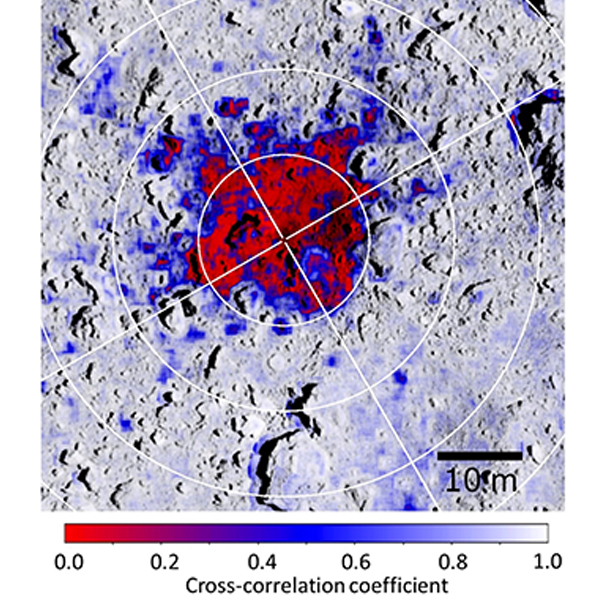
Figure 5. Cross-correlation coefficient map of the area around the SCI crater superimposed on the post-impact image.
The cross-correlation coefficient is described by the color gradient on the map. Numbers and arrows indicate four projections showing the low cross-correlation coefficient. Image credit: Kobe University, JAXA, The University of Tokyo, Kochi University, Rikkyo University, Chiba Institute of Technology, Meiji University, The University of Aizu, AIST.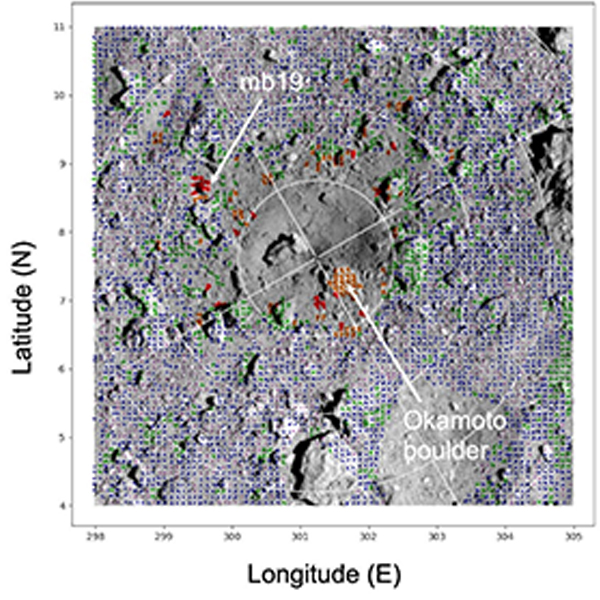
Figure 6. The distribution of motion vectors around the SCI crater.
The arrows indicate the movement of each boulder from their initial positions as a result of the impact. Each color shows the distance moved as follows: purple for 0-1cm, blue for 1-3cm, green for 3-10cm, orange for 10-30cm, and red for 30-100cm. Image credit: Kobe University, JAXA, The University of Tokyo, Kochi University, Rikkyo University, Chiba Institute of Technology, Meiji University, The University of Aizu, AIST.Displacements larger than 3cm were detected within a 15m distance with a probability of more than 50%, and between 15m and 30m with a probability of approximately 10%. Therefore, Arakawa et al. propose, in accordance with Matsue et al. (2020)’s experimental results, that the seismic shaking caused most of the area’s boulders to move at a maximum acceleration 7 times larger than Ryugu’s surface gravity (gryugu). Furthermore, they also discovered that the impact moved boulders at a maximum acceleration of between 7gryugu and 1gryugu in about 10% of the area. It is hoped that these results will inform future numerical simulations of small body collisions, as well as planetary missions involving artificial impacts.
Quelle: University Kobe
+++
JAXA preparing to retrieve Hayabusa2 capsule
Japan's space agency says members of a team tasked with retrieving the capsule from the Hayabusa2 probe will be quarantined for more than three weeks before beginning their task.
The Japan Aerospace Exploration Agency, or JAXA, plans to send the 73-member team to Australia, where the capsule is scheduled to land in a desert area in early December.
JAXA told reporters on Thursday that the members will be sent in two groups. They will quarantine themselves for more than a week in Japan and for two weeks in Australia as a coronavirus-related precaution.
The members plan to start full-fledged preparations around November 24 for retrieving the capsule.
Scientists believe that Hayabusa2 has successfully collected samples, such as sand, from the asteroid Ryugu.
They say the probe is flying home on the right track and it successfully adjusted its trajectory with chemical engines on October 22 when it was about 17 million kilometers from Earth. A similar maneuver is planned in mid-November.
On December 6, the probe will discharge the capsule into the Earth's atmosphere as planned.
JAXA project manager Tsuda Yuichi says he feels a bit tense, but he is looking forward to seeing the team head to Australia soon.
Quelle: NHK


